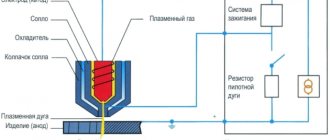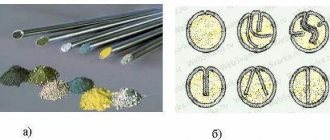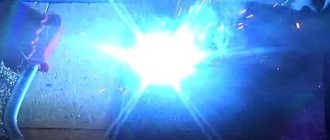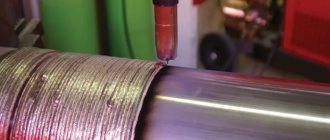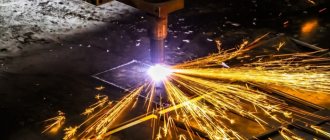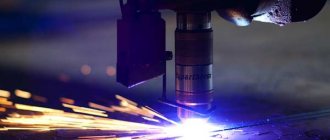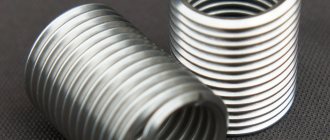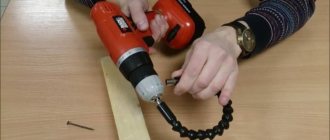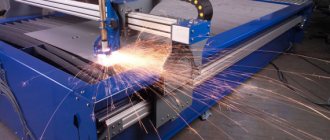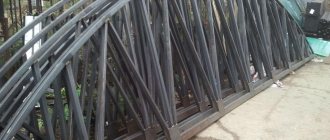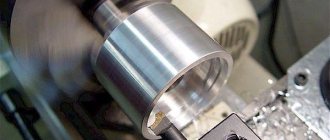Surfacing is the application of an additional layer of metal to the surface of various products and parts by welding.
This procedure not only restores the original properties of the part, but also gives it additional valuable characteristics. It is one of the simplest and most effective ways to return elements to functionality. Fusing can be done for various purposes :
- restoration of product geometry;
- giving the structure a new shape;
- formation of a layer with specific physical and mechanical properties;
- increasing wear resistance, anti-corrosion, strength, hardness and other properties of the base material.
The essence of the process is the interpenetration of hot materials into each other, occurring at the molecular level. To do this, the surface layer of the main product is heated until it melts to a small depth, and the additive is heated to a liquid state. The resulting connection has a high level of reliability. The main advantage of the technology is the ability to regulate the thickness of this layer within significant limits and apply the additive to elements of various shapes.
Below you will find a detailed overview of all types of surfacing, and then a detailed discussion of surfacing with electrodes.
Types of metal surfacing
Currently, a large number of surfacing methods are used in the industrial and manufacturing fields. Next we will look at the different types of surfacing depending on the type of surfacing material used.
Manual arc surfacing with coated electrodes
Surfacing with coated electrodes is the most universal method; it can be carried out in all spatial positions. It is used both in the industrial sector and in the domestic sphere.
- The popularity of this method is due to several reasons : simplicity, convenience, flexibility, and no need for special equipment.
- Main disadvantages : low productivity, difficult conditions for the performer, instability of the quality of the resulting layer, large penetration of the base material.
Fusing requires the performer to have certain skills.
It is necessary to melt both components at a minimum current. By determining the composition of the metal, the type of electrode is selected, and the thickness and shape of the workpieces affects the diameter of the welding rod. If the thickness of the deposited material is less than 1.5 mm. – then the diameter of the rod should be 3 mm. With a thickness of more than 1.5 mm. – 4-6 mm.
The surface of the part must be cleaned of various types of contaminants.
The need for preheating and subsequent heat treatment also depends on the brand of electrodes used.
Surfacing of steel products is carried out using direct current of reverse polarity.
This method involves the use of various patterns of surfacing welds.
When working with flat products, there are two main types:
- using narrow rollers (in the picture), each subsequent roller should overlap the other by 0.3-0.4 of its width;
- the use of wide rollers, which are obtained with increased transverse movements of the electrode.
Another type is the laying of narrow rollers at some distance from each other. The slag crust is removed after applying several rollers. Then the gaps are also filled with rollers.
Surfacing of cylindrical products is carried out in three ways:
- rollers along the generatrix of the cylinder;
- rollers in closed circles;
- along a helical line.
Cylinder surfacing will be analyzed in more detail below.
Manufacturers and retailers offer a wide range of coated surfacing electrodes. The most popular brands are:
OZN-6 are used for surfacing parts of equipment for various purposes, operating under conditions of significant shock loads and intense wear. Metal deposited using electrodes of this brand has increased resistance to cracking.
OZI-5 electrodes are used for welding of metal-cutting tools and dies. The deposited metal is highly resistant to crushing and abrasion under significant impact loads.
Manual arc surfacing can also be carried out with carbon, graphite or tungsten electrodes. Deposition with these welding materials has limited application and is therefore rarely used.
Vibro-arc surfacing is performed by vibrating the electrode, the amplitude of which is 0.75-1.0 times the diameter of the rod. The procedure is carried out using a reverse polarity current of 80-300 A. At the moment of contact between the main product and the electrode wire, a short circuit occurs, which heats both surfaces to the melting temperature.
This method allows you to obtain a durable and thin layer. At the same time, slight heating eliminates the deformation of the part.
The vibro-arc method is used for fusing external and internal cylindrical, external conical and flat surfaces. This method is also used to restore the following structures: shaft journals, mud pump rods, drill pipe joints and others.
Electroslag surfacing is based on the use of heat generated when current passes through molten slag. The main feature of this method is high productivity. In an hour of work, a performer can obtain hundreds of kilograms of deposited metal. Other characteristic features of ESP: lack of spattering, economical consumption of filler materials and electricity, low heating and cooling rates have a negative effect on the structure of the deposited layer, and a slight tendency of the metal to form pores . [ads-pc-2][ads-mob-2]
For your information! To obtain a stable process, it is necessary that the depth of the slag bath be at least 30 mm. Failure to comply with this rule leads to instability of the process.
Electrodes of various cross-sections can be used as filler material: rods, plates, etc.
Main advantages: the process remains stable in a wide range of current densities: 0.2-300 A/mm2, the ability to deposit layers of large thickness in one pass, this method can be used to work with materials prone to cracking, the ability to give the deposited metal the desired shape .
The main disadvantages: overheating of the main product in the heat-affected zone due to the high heat input of the process, the need for complex and unique equipment, the impossibility of obtaining thin layers, significant preparation time.
Automatic plasma surfacing complex SBI (Austria)
Currently, the plasma cladding method . The heat source is a high-temperature compressed arc produced in special burners. The filler material can be surfacing powder, tape, wire, electrode, etc.
Plasma surfacing with the supply of two consumable electrodes into the bath provides high productivity.
A universal subtype of plasma surfacing is surfacing with powder injection into an arc. When performing such work, a combined type burner is used, which produces two types of arc: direct and indirect. Surfacing powders are fed from the feeder to the burner using a transport gas and are blown into the arc there. During its stay in the arc, most of the powder melts, and it falls on the surface of the main product in the form of droplets.
Before starting welding, the working surface should be cleaned of various contaminants: rust, moisture, scale and oil.
When applying the first surfacing layer, each previous bead must be overlapped by 20-30% of its width.
- Main advantages : high quality of the deposited layer, small depth of penetration of the base metal, high adhesion strength, the ability to obtain layers of small thickness.
- Disadvantages : relatively low level of productivity, presence of complex equipment.
Submerged arc surfacing has several characteristic features: high productivity, great versatility and wide possibilities for alloying the base metal.
There are four types of submerged arc surfacing:
Electric arc surfacing with tape is widely used . The arc that occurs at the end of the electrode strip moves from one edge to the other. These cyclic movements result in a dissipated heat input into the main product.
2. Multielectrode electric arc surfacing . The essence of the process is that the arc automatically occurs at the end of either one or the second electrode, which are located at some distance from each other and have a common current conductor. The arc moves from one rod to another, causing the rods to alternately melt.
3. Multi-arc electric surfacing . This type is in many ways similar to the multielectrode method. Only here the number of electric arcs corresponds to the number of electrodes.
4. Vibrating submerged arc surfacing involves performing the process using oscillatory movements of the electrode.
In addition to the advantages already listed, submerged arc cladding has the following advantages: low losses of electrode metal, absence of radiation.
Disadvantages : large penetration of the base metal, the need to use flux-forming devices, surfacing can only be carried out in the lower spatial position, when working with small-diameter parts and deep internal surfaces, there are difficulties in removing the slag crust.
Surfacing in shielding gases
The most popular method is surfacing with a consumable electrode in a carbon dioxide environment, which is characterized by availability and low cost. This method allows you to work with parts of small diameters and apply layers with a thickness of 0.5 to 3.5 mm on them.
- Main advantages : excellent quality of deposited metal, high productivity.
- Disadvantages : increased level of spattering; to obtain a high-quality additional layer, the use of special wire is necessary.
Surfacing in an inert gas environment is carried out with a consumable and non-consumable electrode.
In the first case, the arc occurs between the electrode and the base metal. Deposition is carried out under automatic electrode wire feeding conditions. The protective medium is a mixture of argon with oxygen or carbon dioxide.
In the second case, graphite electrodes serve as non-consumable electrodes.
tungsten carbon electrodes (in the picture). The filler material is introduced into the arc zone in the form of wire or powder. When surfacing with a carbon rod, surfacing powders are poured onto the main surface and then melted. The deposited layer is of low quality due to the presence of pores, non-metallic inclusions and other defects. When using tungsten rods, an arc occurs between the base metal and the tungsten electrode.
Arc surfacing with flux-cored strips and wires
This method does not require the use of flux or shielding gases. Therefore, the main characteristics of this method are simplicity and maneuverability.
It also creates the opportunity for the performer to work with parts of complex shapes, deep internal surfaces, small-diameter elements, etc.
Arc stability and protection of the molten metal from nitrogen and oxygen from the air are guaranteed by the presence of the necessary core components of the electrode material.
Gas surfacing
This method uses a gas flame produced by special burners as a heat source. Surfacing materials can be wires, rods and rods. The deposition process involving these materials is practically no different from electric arc surfacing.
Recently, gas-powder surfacing has become widespread. This method allows you to strengthen parts with a complex configuration with a thin layer of metal from 0.1 to 0.3 mm. This does not dilute the base metal. The powder is fed into the work area through an oxygen gas flame. As a result of heating, the powder in a plastic and molten state reaches the surface of the part. It then hardens and forms a deposited layer of metal.
- Advantages : low penetration of the base metal, versatility of the technology, the ability to obtain thin layers of deposited metal.
- Disadvantages : low productivity, instability of the quality of the deposited layer, low coefficient of use of filler materials.
Laser surfacing is performed using a highly concentrated energy source - a laser beam. This method does not require the use of vacuum chambers. Rods, tapes, and coatings can be used as filler material.
- Pros : high adhesion strength, low and controlled penetration of the base metal, the ability to obtain thin layers - up to 0.3 mm, slight deformation of parts; ability to work with hard-to-reach surfaces; the laser beam can affect several places at once.
- Disadvantages : low productivity, low efficiency of the entire process, it is necessary to have complex and expensive equipment.
[ads-pc-3][ads-mob-3] Electron beam surfacing is performed in a vacuum and is the melting of base and filler materials with an electron beam. The electron beam allows you to regulate the heating of both the base and filler materials. Moreover, this happens separately, which allows mixing of the two materials to a minimum. Flux-cored or solid wire can be used as filler material.
- Advantages : slight penetration of the base metal, the possibility of obtaining layers of small thickness.
- Disadvantages : the complexity of the equipment and its high cost, the need for biological protection of the performer.
Electrical contact surfacing is carried out with wire or powder using a special apparatus.
- Advantages : high productivity, low energy consumption, no need for a protective environment, minimal thermal impact zone due to short pulse duration.
- Disadvantages : limited range of processed products. This method is used to restore the following parts: shafts, axles, rods, drums and other elements, the wear of which does not exceed 1-1.5 mm in diameter.
For friction surfacing, a filler rod is used, which is pressed with its end against the surface to be deposited and rotated relative to the longitudinal axis.
This method has not found active use due to the low relief of the deposited layer.
Explosion surfacing. Cladding using explosion energy is carried out using explosion welding technology.
- Advantages : the ability to work with metals that are difficult or impossible to join using other methods, no penetration of the base metal, minimal level of product deformation.
- Disadvantages : the need for special testing grounds, significant preparation time, limited range of parts that are processed by this method.
Semi-automatic and automatic arc surfacing
All main methods of mechanized arc welding are used for surfacing - submerged arc welding, shielding gases and self-shielding wires and tapes.
When surfacing under flux (wire, tape, etc.) (Fig. 8.1, e, f), the arc is hidden under a layer of granular flux, previously poured onto the surface of the base metal. For submerged surfacing, electrodes are used in the form of one or more wires with a diameter of 1–6 mm or an electrode strip with a thickness of 0.4–1.0 mm and a width of 20–100 mm. Molten slag reliably isolates the liquid metal from air gases and helps preserve the heat of the arc. After the metal hardens, a weld bead is formed, covered with a slag crust and unmelted flux. The cooled slag crust is removed. Using submerged arc surfacing, you can apply a layer of metal of almost any chemical composition with a thickness of 2 mm or more. This process is used for surfacing cylindrical surfaces, as well as all kinds of flat parts and curved products (hydraulic turbine blades).
The submerged arc surfacing process is distinguished by its great versatility, wide possibilities for alloying the metal of the deposited layer and increased labor productivity.
Electric arc surfacing with tape has become widespread
. The arc at the end of the tape (Fig. 8.1, e) moves cyclically from one edge to the other depending on the current and the width of the tape at a speed of 1 - 4 m/s. Due to the movement of the arc, dissipated heat input into the base metal is obtained, which reduces the depth of penetration of the base metal and its share in the deposit to 10 - 15%.
Figure 8.2 shows some examples characterizing ways to increase labor productivity and quality during submerged arc surfacing. The most widely used methods are multi-electrode and multi-arc surfacing.
The essence of the multielectrode electric arc
Submerged arc surfacing is that the arc automatically occurs at the end of one or the other electrode, located at a certain distance from each other and having one common current supply. The arc, moving from one electrode to another, leads to alternating melting of the electrodes, which ensures a small penetration depth with high process productivity.
Fig.8.2. Submerged arc surfacing methods: a – electrode tape; b – multielectrode; c – multi-arc; d – transverse vibration of the electrode
With multi-electrode surfacing, due to the movement of the arc from one electrode to another, the duration of its burning on one of the electrodes is significantly less than with single-electrode surfacing. This reduces the duration of exposure of the arc to the molten metal of the bath in a certain place. As a result, the depth of the crater and the penetration of the base metal are reduced.
Vibration arc surfacing
submerged
_
The desire to maintain good quality of surfacing obtained under a layer of flux and to reduce residual deformations has led to the use of electrode vibration during surfacing, which ensures reliable ignition and burning of the arc at very low operating parameters. In combination with cooling of the welded part, this method provides a significant reduction in residual deformations with high mechanical properties.
A diagram of a device for surfacing small-diameter shafts in this way is shown in Fig. 8.3. Flux holding device 2 is attached to the welding head and moves with it. For better separation of slag and cooling of the welded part, a cooler 3 is installed, supplying compressed air.
Fig.8.3. Scheme of vibro-arc submerged arc surfacing
The main advantages of submerged arc surfacing:
versatility; high performance; the ability to obtain deposited metal of almost any alloying system; low losses of electrode metal; no arc radiation.
Main disadvantages:
large penetration of the base metal, especially when surfacing with wires; impossibility of visual observation of the formation of rollers; the need to use various flux-holding and forming devices; impossibility of surfacing in spatial positions other than the bottom; difficulty in removing slag crust when surfacing small-diameter parts and deep internal surfaces.
Surfacing in shielding gases. Among the methods of surfacing in an environment of active protective gases
Surfacing with a consumable electrode in an environment of cheap and abundant carbon dioxide has become the most widespread. This method makes it possible to apply high-quality layers 0.5 – 3.5 mm thick at high productivity to parts of small diameters. Disadvantages include increased metal spattering (up to 15%) and the need to use special alloy wire to obtain high-quality layers.
Surfacing in various gas mixtures (12% CO2 and 88% Ar; 3% O2 and 97% Ar, etc.) is promising. This method makes it possible to obtain layers with high mechanical properties, especially in terms of fatigue resistance and impact strength.
Surfacing in an inert gas environment
carried out with non-consumable and consumable electrodes.
For surfacing with a non-consumable electrode, carbon (graphite) rods with a diameter of 5 - 40 mm and tungsten rods are used as non-consumable electrodes. In this case, the filler metal is introduced into the arc zone in the form of a wire (rod) or in the form of a powder. When surfacing with a carbon (graphite) electrode, surfacing powders are poured onto the surface to be deposited and then melted (see Fig. 8.1, a). The deposited metal is of low quality due to oxidation of alloying elements, formation of pores, non-metallic inclusions and other defects. Surfacing with a tungsten electrode in an inert gas environment is characterized by the fact that an arc, due to the heat of which the surfacing filler metal melts, occurs between the base metal and the tungsten electrode (see Fig. 8.1, c). The process of argon arc surfacing, similar to gas surfacing, occurs under conditions of feeding a surfacing rod and melting it with an arc.
The use of mechanized means of supplying surfacing material at a constant speed allows surfacing to be carried out in automatic or semi-automatic mode. The inert gas protects the surfacing zone well from the air atmosphere, so this method is especially effective when surfacing non-ferrous metals, high-alloy steels and other materials sensitive to oxidation and nitriding. In this case, a wide range of surfacing materials is used and high-quality deposited metal is formed. A stable bell-shaped arc is formed over a wide range of current strength, which results in an even bead of weld metal with a smooth surface. This method is inferior to consumable electrode surfacing in terms of productivity due to the high energy concentration and low efficiency of using arc heat.
Surfacing with a consumable electrode in a protective gas environment (see Fig. 8.1, d) is characterized by the fact that an arc occurs between the base metal and the electrode surfacing material. Surfacing occurs under automatic electrode wire feeding conditions. Argon is most often used as a shielding gas, although when working in a pure argon environment, the arc loses stability when surfacing any material except aluminum alloys. In order to stabilize the arc when surfacing steel, up to 20% oxygen or carbon dioxide is added to argon, which significantly affects the surfacing process. Therefore, the task of obtaining deposited metal with specified properties requires careful selection of the composition of the shielding gas.
Arc surfacing with self-shielding flux-cored wires and tapes has now become widespread. Stabilization of the arc, alloying and protection of the molten metal from nitrogen and atmospheric oxygen is ensured by the corresponding components of the core of the electrode material. In this case, gas and slag-forming components make up 10–12% of the mass of the wire or tape (Fig. 8.4). This surfacing is promising for strengthening parts of complex shapes, when surfacing them under a layer of flux is difficult.
When such a wire is melted, the alloying elements of the charge and the sheath metal pass into the weld, forming a deposited metal. The weld bead is covered with a thin layer of slag, sufficient to protect it from exposure to air and does not require removal during multi-layer surfacing. Flux-cored wires with internal protection for automatic and mechanized surfacing are manufactured in diameters: 1.6; 2.0; 2.5; 2.8; 3.0; 3.2 mm.
Rice. 8.4. Flux-cored wire designs Fig. 8.5. Scheme of electroslag surfacing
(a) and tapes (b)
When surfacing large parts, instead of flux-cored wire, flux-cored tape of a similar composition is used, which provides an additional gain in productivity.
Surfacing of gear teeth
The gear is a part of many mechanisms and machines used in various industries. The most common defects of this element are wear of the teeth along the length and thickness, chipping, formation of scoring, cracks and scratches. The most effective restoration method is surfacing of worn parts.
If no more than two teeth in a row break in not particularly critical mechanisms, repairs are allowed, including the following procedures: the defective teeth are cut out, 2-3 holes are drilled along the width of the tooth, threads are cut into them, pins are made and screwed into the prepared holes, the pins are welded to the gear and the metal is deposited by electric welding, the deposited layer is given the shape of a tooth.
Restoration of worn gear teeth can also be carried out with special electrodes for surfacing, for example OZN-300. Before work, the product is cleaned of contaminants.
How it's done. The nominal dimensions of the teeth are maintained using a copper template made from an undamaged tooth.
When restoring gears with several defective teeth, repairs are carried out only on the worn side of the tooth. For this purpose, sormite alloys are used, surfacing is carried out using the gas or electric arc method. Surfacing is carried out using electrodes TsS-1 and TsS-2. The work is performed on direct and alternating current of reverse polarity. Then the teeth are ground.
Schemes for surfacing layers at the gear tooth and cavity
The performer can also use stalinite, a powdered alloy that is melted with a carbon or steel electrode using a direct current of reverse polarity. Then the powder in a plastic state is applied to the part in a layer 3-4 mm thick. Borax should be used as a flux.
For repairing the ends of teeth with wear along the length of 2.2-8.2 mm. It is recommended to use automatic surfacing of each worn tooth separately. The process is carried out using flux cored wire. The weld metal is formed in a cooled copper mold.
What types of surfacing exist?
The variety we are considering is far from the only one of the current technologies. Therefore, we will pay attention to other options - also deserving the right to popularity - and then return to ours.
Submerged - carried out using wires - one or more, powder or solid, strip or round in cross-section.
In a protective gas - with immersion in a medium of hydrogen, nitrogen, argon; in this case, there is some overestimation of labor productivity - it is measured by the size, area or mass of the applied material.
Vibro-arc - the electrode is affected by vibrations with an amplitude of 0.75-1 of its diameter; this allows you to speed up the process and achieve a more uniform distribution of the restoration layer.
Electroslag - the coating is formed forcibly and strictly per pass, with convenient adjustment, due to which its total mass can reach hundreds of kilograms per hour (on dimensional parts); The performance of the method is impressive.
Plasma - with a compressed high-temperature jet as a heat source; The most common option today is a direct burner, although combined burners are also in demand. As an additive, you can take tape, wire, fine-grained powder, and the latter is especially convenient - it is easy to supply with gas and simply blow in, it quickly becomes liquid and spreads evenly over the surface.
Open arc - performed mechanically, without the use of a gaseous medium or flux. The method is quite universal and therefore makes it possible to restore even complex, concave or convex surfaces, small diameters and much more. Another area in which it is involved is the strengthening of products subject to consistently high loads.
Surfacing of rail ends
Photo source: specserver.com
The operation of high-speed trains requires good condition of the rails. Wheel impacts lead to deformation, crushing and bending of the ends of the rails. Restoration by surfacing is a standard technique.
Before starting work, all flattened and peeled metal is removed from the rail. To do this, it is recommended to use a chisel, emery wheel or other tool. To increase the deposition rate, it is necessary to preheat the ends of the rails.
The following surfacing technologies are used on Russian railways to restore rail ends:
1. Manual arc surfacing is performed with a piece electrode of the K-2-55, OZN-300, OZN-350 brands. The rollers are applied in three ways: along, across the rail and diagonally. The best results are obtained when working with the second method. The average width of the roller is 24-30 mm. This value may vary depending on the diameter of the rod, current strength and other factors.
There is also the possibility of fusing a bunch of electrodes: 2-3 rods arranged in a comb. This method improves productivity. Surfacing should begin at the end of the rail by applying a bead. The arc is excited on the inside, making a small indent from the end. The deposition of the first bead is also completed by moving slightly away from the end of the rail. The ends of each of these rollers are brought to the end of the previous roller and the crater is sealed there. The overlap of adjacent rollers should be 1/5-1/6 of the width of the previous roller. The work ends with grinding the ends of the rails along the rail.
2.
as a filler material when performing semi-automatic electric arc surfacing . This method has several advantages compared to the manual arc method: high quality of work, significant labor productivity.
The work is carried out in stages:
- defect measurement;
- preparation of equipment for surfacing;
- removal of defects by grinding;
- installation of surfacing apparatus on rails and setting work boundaries;
- heating the working area;
- performing the main process - deposition;
- mechanical processing with an abrasive tool after natural cooling.
Surfacing is carried out in one or several words, depending on the depth of the defect.
Restoration of machine parts using surfacing methods
Khrapkov G.A., Kurochkin O.A., Nikitin A.S. NPO "Technoplasma" Magazine "Construction and road machines" No. 11'1999
Many road construction enterprises widely use remanufactured parts due to the high cost and shortage of spare parts.
Depending on the need for spare parts and the technical equipment of the enterprise, work on restoring parts can be carried out in various ways, both in-house and in repair organizations.
These methods include surfacing: manual arc, under a layer of flux, flux-cored wires, vibrating arc, plasma, laser, in a protective gas environment.
One of the most common and accessible methods of restoring worn parts is the method of manual arc surfacing with an electrode.
. The advantages of this method: simplicity, availability of necessary equipment, availability of consumables. Disadvantages: strong heating of parts and, as a result, in many cases their warping, low performance properties of the deposited surface.
Surfacing under a layer of flux
characterized by high productivity, the ability to obtain a deposited layer up to 10 mm thick. Disadvantages: high heating, as well as significant mixing of the base and filler materials.
Vibration arc surfacing
used in many enterprises due to the simplicity of the equipment and the ability to restore both external and internal surfaces. However, the quality of the surfacing is low; the restored surface often results in pores and non-uniform hardness.
Surfacing in a protective gas environment with a consumable electrode
has become most widespread at repair enterprises due to its low cost, availability of consumables, and the possibility of restoring not only steel and cast iron, but also bronze and bimetallic parts. Disadvantages include increased spattering and significant thermal effects.
Laser surfacing
- a progressive, high-tech method. It is characterized by low heating of the welded part and high quality of surfacing. Currently, it is not widely used due to the high cost of restoring parts, the need for maintenance by highly qualified personnel and compliance with safety requirements.
Recently, plasma technologies
. Restoration of parts by plasma surfacing (figure) is organized at enterprises in Moscow and the Moscow region, Nizhny Novgorod region, Tatarstan, Chelyabinsk, Ulyanovsk.
The range of restored parts is varied: track pins, balancer axles, pivots, hydraulic pump parts, electric motor rotor shafts, crosspieces and other parts.
The insignificant melting depth of the base metal (up to 0.5 mm) and its low content in the deposited layer (up to 5%) make it possible to preserve the original properties of the deposited material practically without changing.
Depending on the requirements for the surface of the parts being restored, surfacing can be done with powdered high-alloy iron-based alloys, self-fluxing alloys or powders based on chromium, boron, nickel and copper.
Iron-based powder alloys, depending on the grade, provide the hardness of the deposited layer in the range of HRCе 44 - 62 and give the surface high wear resistance when working in normal and abrasive environments. Self-fluxing alloys, depending on the grade, provide the hardness of the deposited layer in the range of HRCе 29 - 60 and give the deposited layer corrosion resistance and wear resistance.
In terms of the emission of harmful substances into the atmosphere, plasma surfacing technology is close to argon arc welding technology. The noise level does not exceed 35 - 60 dB, the noise arises mainly due to the operation of the welding current source.
The basic equipment for plasma surfacing is a rotator (lathe) and a welding rectifier, which, as a rule, are already available at enterprises. To restore various parts, various types of plasmatrons have been developed, characterized by reliability, durability and ease of maintenance.
Combinations of various powders or powder and wire make it possible to widely change the performance properties of the deposited layers.
Plasma surfacing allows you to apply layers with a thickness of 0.3 to 5 mm, which makes it possible to restore parts with a lot of wear.
Plasma surfacing technology makes it possible to increase the fatigue strength of extremely worn crankshafts of diesel engines from 60 to 83 - 92% of the strength of new ones, the wear resistance of the deposited layers is not lower than new ones [1,2].
The welded surfaces of crankshafts are processed on cylindrical grinding or lathes.
Crankshafts restored using this method can operate under conditions of large alternating and dynamic loads.
Bibliography:
- Sidorov A.I. Restoration of machine parts by spraying and surfacing. M.: Mechanical Engineering, 1987.
- Gusenkov A.P. and others. Methods and means of hardening the surfaces of machine parts with concentrated energy flows. M.: Nauka, 1992.
Surfacing of cylinders and planes
To restore the surface of cylinders, the following fusing methods are used:
1. Surfacing with coated electrodes is carried out in three ways: a) with rollers along the generatrix of the cylinder (longitudinal surfacing); b) rollers in closed circles (circular surfacing) and c) along a helical line.
Products of small diameter and considerable length should be processed using the first method . A bead is fused onto the cleaned surface. Then the part is rotated 180° and a second bead is deposited on the opposite side. Afterwards, the product is rotated 90° and the third bead is fused, and after 180° - the fourth. Next, a fifth bead is deposited, which overlaps the first. It should be noted that before applying the next roller, the previous ones must be cleared of slag.
The second method implies that the part must rotate around its axis during the entire working process. The latter option is especially convenient in the case of mechanized surfacing, in which the part rotates uniformly .
2. Automatic submerged arc surfacing ensures a wear-resistant layer. This method can be carried out with welding or flux-cored wire, strip electrode, flux-cored tape. Here two methods should be distinguished: deposition is carried out along a generatrix or along a helical line.
To restore flat products, it is necessary to cover large areas with minimal penetration of the base metal . A short video of surfacing with a plowshare will give you an idea of the operation.
to repair flat surfaces :
Narrow rollers are used; each subsequent roller is located overlapping the previous one by 0.3-0.4 of its width; slag is removed immediately from all weld beads.
Laying narrow rollers at a certain distance from one another is one of the simplest methods. The slag should be removed after applying several beads. After this, the beads are also fused in the gaps.
Wide-layer surfacing is a more advanced technology. Transverse oscillatory movements are imparted to the electrode.
Multi-electrode surfacing and electrode strip surfacing are characterized by increased productivity.
To obtain a wear-resistant layer, surfacing should be performed using flux-cored wire and open-arc tape. In this case, transverse vibrations with the required range are imparted to the electrode. This case is characterized by the absence of a slag crust of significant thickness.
In electroslag surfacing, flux-cored wire or solid wire can be used as the electrode material. [ads-pc-4][ads-mob-4]
About different methods of restoring a seat on a shaft or surfacing versus sputtering
In this article I will try to find out the most effective way to restore a damaged shaft journal. By “neck” in this case I mean any seating surface on the shaft: for a rolling bearing, for a Babbitt bearing, or for the drive cylindrical or tapered end of a shaft for a coupling with keyways. Let's consider the three most common options for restoring the surface of the journal: 1) manufacturing a bushing and subsequent interference fit, 2) electric arc surfacing, 3) thermal spraying.
Making a bushing. Advantages: the entire technological process can be carried out by a turner, and there is no need to involve other specialists. Disadvantages: a very labor-intensive method, the choice of material for restoration is limited, it is impossible to restore a journal that has a smaller diameter than neighboring journals (for example, crankshaft journals), it is impossible to restore a journal with keyways.
Electric arc surfacing. Advantages: the coating is monolithically connected to the base; there is a choice of surfacing materials with different properties. Disadvantages: when restoring minor wear (which most often happens), the main part of the deposited metal (50 - 80%) goes into chips during subsequent machining; the shaft during arc surfacing is deformed due to intense heating (only the end of the shaft can be welded without deformation). Shafts are usually made of carbon steels (35, 40, 40X, etc.), which are hardened during surfacing, which can lead to cracking in areas adjacent to the surfacing. Heat treatment accompanying surfacing is required (at a minimum, preheating).
Gas thermal spraying. Advantages: complete and fundamental absence of thermal structural transformations and thermal deformations in the part due to low heating temperatures with this restoration technology (not higher than 250 degrees C); the presence of open micropores in the coating has a beneficial effect on the operating conditions of friction pairs, since a small amount of lubricant is constantly retained in the pores. Disadvantages: due to weak adhesion to the surface of the part, the sprayed coating can only work in compression, and if, due to operating conditions, large shear loads can occur on the surface, then this surface should not be restored by spraying.
I propose to weigh the indicated pros and cons of the three methods in relation to, for example, the restoration of a cylindrical drive end of a shaft made of 35X steel in a heat-treated state with a nominal diameter of 150 mm and a length of 150 mm, having a keyway. At the time of repair, the diameter is at least 149.5 mm. A coupling or pulley can be fitted to this end. In my opinion, this is a fairly common case.
The presence of a keyway, as you understand, excludes the possibility of installing a bushing, and therefore we will not consider this extremely low-tech method.
Let's calculate the costs of electric arc surfacing. We will surfacing with cheap domestic electrodes NII-48G with a utilization factor of 0.58 and a surfacing productivity of 1.9 kg/h (data from Spetselektrod JSC Moscow). Let us take the average thickness of the deposited layer to be 3 mm. For this we will need 2.9 kg of electrodes (1,102.00 rubles excluding VAT) and 1.53 hours of pure arc burning time (excluding time for turning the product, replacing electrodes, etc.).
Let's calculate the costs of flame powder spraying. The productivity of the method is 3.2 kg/hour. We will spray a layer of 1 mm per side. This will be quite enough for allowance for machining, since spraying is carried out in a lathe with a uniform burner feed, and we will get the same thickness of the sprayed layer over the entire restored surface. To do this, we need 0.6 kg of powder (1,314.94 rubles excluding VAT) and 0.19 hours of pure spraying time. Here you need to take into account that there is no need to interrupt the spraying process for any kind of auxiliary operations.
Also, please pay attention to the subsequent mechanical processing, the volume of which during surfacing is significantly higher (compare 2 mm and 0.5 mm allowance for the radius) and practice shows that when peeling a bumpy deposited surface containing remnants of a slag crust, a turner has to stop to refill a dull cutter.
Let's consider the risks. When arc surfacing a shaft made of 35X steel, preheating to approximately 250 degrees C is necessary in order to avoid the formation of brittle structures and, as a consequence, cracks in the metal adjacent to the surfacing. If this requirement is ignored, the restored shaft end may break off along the edge of the welded zone when operating under load. Also, during the surfacing process, it is possible to overheat the end of the shaft and thereby weaken the steel, reducing its strength. When spraying, there is no risk of changing the structure of the base material, since the temperature of the product does not exceed 200 degrees C during the entire process.
Summary. 1. Spraying is suitable for restoring any seats on shafts where there is no need to transmit large torque through contact with the surface. 2. The spraying process has costs for materials commensurate with the costs of domestic surfacing electrodes and at the same time an order of magnitude less (about 10 times) working time costs. 3. Spraying is a safe method, as it does not weaken the part being restored. 4. Spraying is a convenient method, since to restore the shaft you need to install it in a lathe once, and upon completion of the procedure, remove the finished shaft from it once.
The conclusions of this article, of course, should not be unconditionally applied to all cases of recovery, but I am sure there is some truth in all of the above. If you disagree with the author in any way, please contact me and point out my mistakes.
Thank you for reading.
Best regards, Alexander Nazarov.
September 2011
Surfacing of metal-cutting tools and dies
Restoration of metal-cutting tools and dies is performed by arc surfacing in three ways: manual, automatic and semi-automatic.
The first option involves the use of electrodes. Metal-cutting tools and dies operate during cold and hot stamping, so they should be restored using the following grades of electrodes: OZI-3; OZI-5; OZI-6; TsS-1; CI-1M. The layer deposited with such materials has a high level of resistance to abrasion and crushing under heavy loads and high temperatures (up to 650-850°C). The product must be heated to 300-700°C before fusing. Fusing is carried out in 1-3 layers, the thickness is 2-6 mm.
We invite you to watch a video demonstration of the Zeller 769 electrode surfacing test.
Automatic and semi-automatic methods are carried out with alloyed wire using fluxes or pastes.
Surfacing of parts exposed to abrasion with impact loads and without impact loads
Products operating under conditions of intense surface wear and high shock loads must be overlaid with electrodes of the following brands:
Welding electrodes for surfacing OZN-400M
Advantages of OMG-N: they comply with state standards, deposition can be carried out with direct and alternating current of reverse polarity.
TsNIIN-4 is one of the most popular and popular brands.
Metal deposited with OZN-7M rods during multilayer deposition has increased resistance to cracking.
Advantages of OZN-400M: high productivity, deposited metal is characterized by increased hardness.
Advantages of OZN-300M: the deposited metal has increased stability of wear resistance and hardness; surfacing is performed with direct and alternating current of reverse polarity.
An example of such parts is elements of construction and earth-moving equipment.
For surfacing parts exposed to abrasion and without shock loads, the following grades of electrodes are used.
To obtain a deposited layer of special hardness, it is necessary to use surfacing electrodes T-590 and T-620. These brands are intended for repairing parts subject to intense abrasion. Thanks to a special coating, which includes ferrochrome, ferrotitanium, ferroboron, boron carbide and graphite, the hardness of the deposited metal can reach 62-64 HRC. Metal deposited with T-590 and T-620 materials is brittle and prone to cracking, and is therefore not intended to withstand significant shock loads. Fusing is carried out in 1-2 layers.
Repair of products made of various metals and alloys also has its own specific characteristics.
Surfacing of stainless steels
The most popular electrodes for surfacing corrosion-resistant steels are grades TsN-6L, TsN-12M-67. The core of such materials is a stainless high-alloy wire. The deposited metal has the following characteristic features: high corrosion resistance, resistance to scuffing. The second property allows these electrodes to be used for surfacing reinforcement products. The need for preheating (up to 300-600°C) and subsequent heat treatment depends on the brand of materials used.
The features of the welding process of stainless steels can be found in the article “Welding stainless steel”.
Shaft surfacing
We have the following instructions for repairing power equipment shafts. It might be useful to you too.
If it is necessary to provide specific dimensions of the seats, and the depth of the defects does not exceed 1 mm from the nominal diameter, it is preferable to use the flame spraying method in the following sequence:
— the seats are machined to completely remove corrosion and ensure a roughness of Rz 120 or more;
– when the shaft rotates from 5 to 15 rpm, a uniform gas-flame spraying of a metal layer up to 2.5 mm thick is performed on the treated seats;
– no less than 4 hours after spraying, the seats are ground and sanded to ensure the required diameters, roughness and cylindricity.
If it is necessary to provide specific dimensions of the seats, and the depth of the defects exceeds 1 mm from the nominal diameter, the electric arc surfacing method is used in the following sequence:
– grind surfaces that need restoration until visible defects are eliminated, but to a depth of at least 3 mm
– carry out visual inspection and MTD of prepared surfaces and all places - stress concentrators (fillet transitions, ledges, etc.)
– if previously hidden defects are detected, draw up an additional defect inspection report and inform the Customer;
– install a false key into the keyway or strengthen the groove walls with copper plates;
– preheat to a temperature of 150 to 200 °C in a furnace with a bogie hearth;
– protect adjacent surfaces from splashes of molten metal with an asbestos cord or removable metal casings;
– perform surfacing to a diameter exceeding the nominal from 3 to 6 mm semi-automatically in a carbon dioxide environment with welding wire Sv-08G2S GOST 2246-70 with a current of 100 to 130 A, with ring rollers, avoiding long interruptions in work;
– for uniform cooling, load the shaft into a heated oven or cover it with insulating material until it cools completely;
– install the shaft on the lathe, align it along the base surfaces;
– re-center the shaft, if necessary;
– carry out preliminary turning of surfaces according to the drawing with allowances from 0.2 to 0.3 mm per side;
– carry out visual inspection and MPD of the deposited surfaces and all places - stress concentrators (fillet transitions, ledges, etc.), if defects are detected, repeat the surfacing and preliminary turning;
- final sharpening and sanding of the surface according to the drawing;
– without removing the shaft from the machine, carry out quality control of the restoration of the seats.
A special rotator is used for surfacing ring beads.
I think a finished lathe would also work. Modified June 8, 2011 by ZHAN
Surfacing of cast iron and its alloys
The most popular brands of electrodes for surfacing cast iron are:
Electrodes TsCh 4.
OZCH-2 are designed for surfacing ductile and gray cast iron.
MNCh-2 electrodes ensure the density and cleanliness of the deposited layer (after processing).
OZZHN-1 and OZZHN-2 are used for working with gray and high-strength cast iron.
TsCh-4 electrodes have good welding and technological characteristics: ease of ignition and stability of the arc, low spatter.
Some grades are universal; they can be used to weld various types of cast iron: malleable, gray, etc. Most are intended for certain types of alloys. A complete list of electrodes for welding cast iron can be found in the corresponding section.
Surfacing of copper and its alloys (bronze)
Products made from technically pure copper are deposited using Komsomolets-100 electrodes or filler rods, the composition of which is close to the composition of the base metal. It is recommended to use preheating to 300-500°C. If the copper temperature exceeds 500°C, then the deposited layer must be forged.
If it is necessary to surfacing bronzes, it is better to use OZB-2M electrodes. The deposited metal has high surface wear resistance.
Surfacing of copper and its alloys is carried out using direct current of reverse polarity exclusively in the lower spatial position.
The brands of electrodes intended for welding copper and its alloys can be found in the corresponding section.
Types of manual welding and surfacing
There are several parameters by which they are classified.
For example, there is a common division:
- • by the nature of the arc – compressed (short) and free (long);
- • according to the type of electrode used – with a melting rod (coated) and not;
- • according to the effect on the base metal of the part - direct, three-phase, indirect.
They are also grouped according to the result, that is, according to the restored layer - into:
- M – thin;
- C – average;
- D – thick;
- G – especially thick.
They are classified separately by purpose - options for connection are distinguished:
- • low-alloy and carbon steels;
- • alloyed and heat-resistant;
- • alloys with special properties;
- • layers with non-standard characteristics.
Now we will schematically consider the main methods of manual arc welding and surfacing:
They use:
A – carbon electrode (1) and bulk alloy (2);
B – coated (1) and alloying layer (2);
B – tungsten conductor (1) and filler rod (2) in inert gas;
G – rod (1) in a protective environment;
D – wire (1) and flux (2);
E – tape (1);
G – plasmatron jet (1) and powder (2), already sintered or applied;
Z – conductor (1), copper slider (2), workpiece (3), restoring coating (4).
The choice of a specific option depends on the specific conditions in which the work is carried out, on the planned result and on the required productivity. But each of them can be implemented quite simply and quickly.
Surfacing of aluminum and its alloys
OZA-1 electrodes.
The most effective restoration method is arc surfacing. Electrodes of the OZA, OZANA and UANA brands are intended for products and structures made of aluminum and its alloys.
Consumables OZA-1 ensures the production of metal with high corrosion resistance.
The special coating of OZANA-1 electrodes allows you to normalize the process and destroy the oxide coating formed on aluminum products during work.
To regulate the structural composition of the deposited metal, powder electrodes should be used. Electrodes of this type make it possible to create not only a deposited layer of equal strength to the base metal, but also a layer with significantly improved characteristics.
A complete list of electrodes for welding aluminum and its alloys is presented in the corresponding section.
Consumption of materials
To determine the cost of the finished product, it is important to correctly calculate the consumption of surfacing materials. Calculations are carried out in accordance with accepted standards for each specific type of work and materials. Also, knowing the exact quantity of necessary consumables can ensure process continuity and create reserves of materials.
Calculation of deposited metal during welding is one of the main indicators. There is a special formula to determine the value of this coefficient. The mass is calculated per 1 meter of weld. How to determine the mass of deposited metal during welding will be analyzed further:
G = F * y * L, where: F – cross-sectional area of the weld (in mm2) y – specific gravity of the metal (g/cm3) L – length of the weld is 1 meter.
Thanks to this formula, any performer will be able to calculate the mass of deposited metal during welding.
Calculation of electrodes for surfacing is also a significant quantitative parameter. The performer does not need to perform calculations to determine this value. Each brand of welding materials has its own indicator - electrode consumption during surfacing of 1 kg. metal varies from 1.4 to 1.8 kg.
to calculate the mass of deposited weld metal per linear meter. According to GOST, each form of weld made of carbon and low-alloy steels, performed by manual electric arc welding with a metal consumable electrode and welding in carbon dioxide, has an average value of this parameter.
Surfacing electrodes
Manufacturers and sales companies offer a wide range of special electrodes for surfacing. The most popular surfacing materials are electrodes from the following manufacturers: “SpetsElektrod” (Moscow), “LEZ”, “SpetsElektrod” (Volgodonsk), “SZSM”, ESAB, Lincoln Electric. The wide range of consumables offered allows the contractor to choose the best option for electrodes to perform specific work. A complete list is presented in the section “Electrodes for surfacing surfaces of layers with special properties.”
Surfacing Services
Many companies operating in the metal processing industry offer related services. Companies provide surfacing services at a professional level, using specialized and modern equipment, and employees with extensive experience and knowledge. Craftsmen can process products of various sizes. Therefore, if the performer cannot carry out the fusing procedure independently, it is more advisable to turn to specialists. This will help significantly save money and time spent.
other services
Restoration of diesel fuel equipment parts Restoration of plunger surfaces Restoration of bearing seats Surfacing of valves Restoration of parts by spraying Restoration of parts by surfacing Restoration of cast iron parts Restoration of parts by welding Repair of stamps and molds Restoration of parts of printing equipment Restoration of food industry parts Repair of shafts Spraying of shafts Restoration of shafts Restoration of parts and components Restoration of parts by metallization Restoration of parts with repair dimensions Restoration of metal parts Restoration of surfaces of parts Restoration of steel parts Restoration of car parts
"Plasmacenter" offers
- services for restoration of parts, coating, vacuum sputtering, microplasma sputtering, electric spark alloying, plasma processing, coating certification, titanium nitride sputtering, shaft repair, corrosion coating, protective coating, hardening of parts;
- supply of equipment for the processes of finishing plasma hardening, welding, soldering, surfacing, spraying (for example, gas-thermal, gas-flame, microplasma, high-speed and detonation spraying), electric spark alloying, control devices, powder dispensers, plasma torches and other equipment;
- supply of consumables such as welding wire, electrodes, welding rods, spraying powders, surfacing powders, additive manufacturing powders, surfacing wire and other materials for welding, surfacing, spraying, additive manufacturing and hardening processes;
- conducting R&D in the field of surface engineering, coating tribology, plasma processing methods, selection of optimal coatings and methods of their application;
- training, consulting in the field of surfacing, sputtering, hardening, modification, hardening.
Contact us by phone: +7 (812) 679-46-74, +7 (921) 973-46-74, or write to us by email.
Our managers will tell you in detail about the technologies we have for coating, hardening, restoring, imparting surface properties, as well as the cost of the company’s services.

